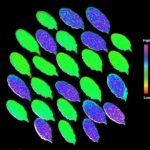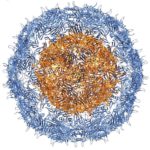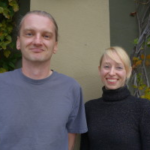MBIB researchers were part of a team that used SLAC’s X-ray free-electron laser (XFEL) – the Linac Coherent Light Source (LCLS), a DOE Office of Science User Facility – to get atomic views of the toxin BinAB, used as a larvicide to control mosquito-borne diseases such as malaria, West Nile virus and viral encephalitis. The structure of this bacterial toxin was solved using de novo phasing: the protein crystals were tagged with heavy metal markers, tens of thousands of diffraction patterns were collected using the XFEL, and the information was combined to obtain a three-dimensional map of the electron density of the protein. The Berkeley team, headed by Senior Scientist Nicholas Sauter, acquired and processed data for the study, published in Nature last week.
Let There Be (More) Light
Excess light energy that a plant can’t absorb needs to be dissipated to avoid damage and oxidative stress. Krishna Niyogi, a faculty scientist in Molecular Biophysics and Integrative Bioimaging and a UC Berkeley professor of plant and microbial biology, led the study that included researchers from Berkeley Lab, UC Berkeley, University of Pennsylvania School of Veterinary Medicine and Colorado State University at Fort Collins. The scientists are studying ways to increase the amount of light that can be safely absorbed, potentially leading to more efficient photosynthesis and higher crop productivity. Read the Berkeley Lab Science Short.
Scientists Find New Way to Manipulate Size of Virus-Like Particles
In their Nano Letters paper released August 23, 2016, a research team led by Danielle Tullman-Ercek, biologist faculty scientist in Molecular Biophysics and Integrated Bioimaging, described a new size selection method for virus-like particle assembly using chromatography. Their work has important implications for virus evolution theory, multi-protein assembly behavior, and protein-based nanomaterial development.
Lab-Developed Beamline Tool Launched by Licensee
Based on a beamstop technology licensed from Berkeley Lab earlier this year, MiTeGen LLC has launched the Sentinel™ Real-time Intensity Monitoring Beamstop System for X-ray beamlines. The device improves data collection from X-ray scattering experiments conducted by researchers seeking potential treatments for cancer, AIDS, Ebola, and other diseases.
The Compact Dynamic Beamstop technology developed by Diane Bryant and Simon Morton (pictured) at the Berkeley Center for Structural Biology and licensed by MiTeGen was named a finalist in the 2016 R&D 100 Awards earlier this month, along with six other Berkeley Lab technologies and one multi-lab collaborative effort. Recently, the developers and MiTeGen staff presented the device at the 2016 American Crystallographic Association meeting in Denver.
PNAS Profile on Nogales Accompanies Inaugural Article
Eva Nogales’ life and research work was highlighted in the PNAS Profile of August 12. The profile, written in recognition of her election to the National Academy of Sciences in 2015, accompanied the PNAS Inaugural Article of Nogales, a faculty structural biologist in the Molecular Biophysics & Integrated Bioimaging Division. In this article, titled “Near-atomic cryo-EM structure of PRC1 bound to the microtubule,” she uses cryo-EM to visualize, at a near-atomic level, how an essential component of the mitotic spindle maintains critical contact with microtubules to aid cell division.
- « Previous Page
- 1
- …
- 63
- 64
- 65
- 66
- 67
- …
- 78
- Next Page »
Was this page useful?








